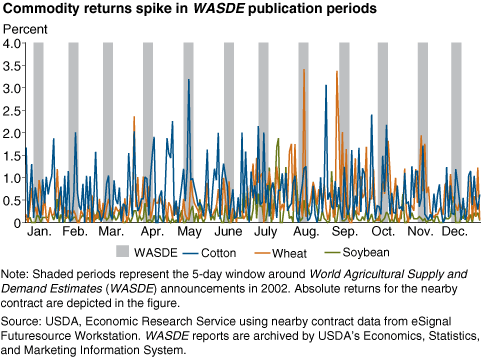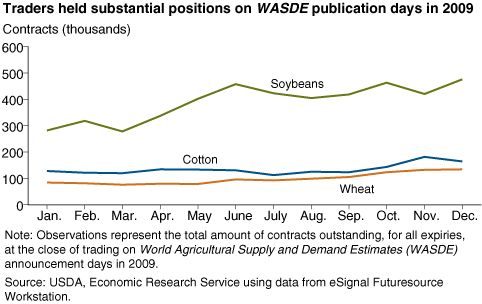Emergence and Impact of USDA’s WASDE Report
- by Michael K. Adjemian
- 6/5/2012
Highlights
- USDA's premier outlook publication, World Agricultural Supply and Demand Estimates (WASDE), draws together domestic and foreign supply, demand, and trade data for key commodities.
- Although the report is viewed by market observers as an important benchmark, the rise of private forecasting services has led some to question the usefulness of USDA's role in commodity market reporting.
- Based on a statistical model that isolates the market's response to news, ERS finds that markets place substantial value on the situation and outlook information published in WASDE.
The collection, analysis, and reporting of commodity market information by USDA, in place for 150 years, serves an important function in the marketplace. Accurate data about the situation and outlook for agricultural commodities improve the efficiency of the production and marketing chain, helping farmers, ranchers, agribusinesses, and governments make informed decisions. The availability of data on crop conditions, supply forecasts, trade, and inventory levels the playing field for producers, merchandisers, and consumers of agricultural products by reducing informational disparities.
USDA's premier situation and outlook report, World Agricultural Supply and Demand Estimates (WASDE), draws together domestic and foreign supply, demand, and trade data for key U.S. commodities. WASDE is published before the opening of major domestic futures markets between the 8th and the 12th day of each month. Many market observers watch the report closely and consider it a benchmark due to its comprehensive nature, objectivity, and timeliness. For this reason, USDA is careful to prevent pre-release of the information in the report, confining those involved in its overnight creation to a 'lockup' environment until formal publication of the report at 8:30 a.m. on the release date.
Still, private agricultural information services have improved over time, leading some in the industry and academia to question the value of USDA's information-reporting program. To determine its usefulness to the market, ERS researchers analyzed the reaction of commodity market prices to 350 WASDE reports published over the 30-year period 1981-2010. Specifically, ERS measured the impact of USDA's situation and outlook information on commodity prices for three commodities in three different markets: cotton on the Intercontinental Exchange (ICE), soybeans on the Chicago Mercantile Exchange (CME), and wheat on the Kansas City Board of Trade (KCBT).
Emergence of the WASDE Report
One year after USDA was established by President Abraham Lincoln, the Department published its first monthly statistical report on crop conditions during the Civil War in 1863. Soon after, the Department added livestock statistics. As communications technology improved over the late 19th century, USDA sought even faster ways of disseminating its commodity data and analysis to market participants, using a telegraph wire service to transmit information to the press and commodity exchanges. By the early 1900s, USDA had released its first planting intentions report and crop production forecasts.
Although the Department understood that commodity markets reacted to its crop and livestock information, the process for creating reports at that time was not well-guarded. In 1905, an insider trading scheme came to light: one of three USDA employees involved in creating the cotton acreage report had leaked advance knowledge of its contents to an outside accomplice by tampering with a window blind. The accomplice used that inside information to place profitable speculative trades but unwittingly exposed details about the plot after publicly complaining about an inaccurate premature signal sent by the USDA employee. The resulting scandal infuriated President Theodore Roosevelt, who asked Congress to criminalize insider disclosure of agricultural statistics reports. Since that time, USDA has quarantined the area where its most important agricultural reports are compiled--and sealed the window blinds--to prevent any leakage of the reports' contents before official publication.
The WASDE report can trace its beginnings to the 'Great Grain Robbery' of 1972. In the years following the New Deal, the number of USDA agencies involved in collecting and analyzing agricultural statistics expanded to the point that, by the 1970s, USDA's economic intelligence system had fragmented. Even though many USDA officials were aware of some of the Soviet Union's grain purchasing activity, without sufficient cross-agency information sharing, the Department as a whole failed to notice that foreign buyers were securing large portions of that year's U.S. grain crop at subsidized prices. USDA addressed these problems, in part, by creating the Agricultural Supply and Demand Estimates report, as well as its later iteration, WASDE, which added data on foreign markets beginning in 1980.
Today, USDA's World Agricultural Outlook Board (WAOB) administers the interagency process that generates WASDE. For each commodity in the report, a WAOB commodity specialist chairs an Interagency Commodity Estimates Committee (ICEC) of experts. Each ICEC comprises representatives from four USDA agencies: the Agricultural Marketing Service provides information on existing prices for livestock and crop commodities; the Economic Research Service analyzes the impact of market conditions on commodity supply-and-demand fundamentals; the Farm Service Agency considers the effect of the policy environment on producer behavior; and the Foreign Agricultural Service provides information about commodity conditions in foreign countries.
Weather analysis is presented by the Joint Agricultural Weather Facility, cooperatively managed by USDA and the U.S. Department of Commerce's National Oceanic and Atmospheric Administration. Each ICEC synthesizes these data in a forecasting cycle based on the local marketing year for its commodity. Several times per year, USDA's National Agricultural Statistics Service (NASS) forecasts the annual domestic harvest in its Crop Production report. The ICEC incorporates these NASS forecasts into WASDE, which is released at the same time as the Crop Production report. Through this process, USDA creates a balance sheet of consensus estimates for each commodity, including the elements of supply and demand, as well as the season-average farm prices. WASDE reports domestic and international balance sheets for coarse grains, corn, cotton, rice, the soybean complex, and wheat. For sugar, Mexican supply and use is provided along with U.S. data. WASDE provides only domestic information for barley, eggs, meat, milk, oats, poultry, and sorghum.
Informational Value of the WASDE Report
According to economic theory, the price of a commodity changes when traders learn new information about its supply-and-demand fundamentals. Consequently, the value of new information to the market can be calculated by the difference in commodity price before and after the report is released. Based on that principle, ERS researchers tested cotton, soybean, and hard winter wheat futures prices for significant changes immediately following WASDE publication over the 30-year period 1981-2010. The research was complicated by the many factors that can affect commodity futures prices, including unexpected shocks, such as weather events, seasonality effects, and inventory levels. In addition, futures prices tend to grow more volatile as a futures contract nears expiry. In 2002, for example, commodity futures prices clearly spiked in certain WASDE publication periods but also experienced significant volatility throughout the year. The researchers were able to account for the influence of observable factors on price movements and isolate economically meaningful market reactions to WASDE. This method also enabled them to pinpoint the reports that market participants deem most valuable and calculate their impact.
The price of a futures contract represents the market's expected value for a standardized amount of a commodity (e.g., 5,000 bushels of wheat) at a future date. On a given day, multiple contracts are traded for the same commodity, differing only by their expiration date (e.g., March, May, July, September, and December for wheat). To trade these contracts, an individual must maintain a collateral account with a commodity broker, so trading returns are best judged against the collateral necessary to earn them (i.e., the return on collateral). ERS estimates that, following WASDE's publication, the average report causes an immediate price change of about $190 per contract for cotton and soybeans and almost $140 per contract for hard red winter wheat at recent prices. These price changes, which correspond to a 1-day return on collateral of around +5 percent to a cotton and wheat trader and +8 percent to a soybean trader, signify that WASDE updates market expectations and is therefore informative. The effect is even stronger in those months when NASS issues its Crop Production reports (e.g., August through January, but not December, for soybeans). ERS estimates that following the most useful reports, at recent prices, WASDE generates about a $600 change per contract, equating to a return on collateral of +15 percent for cotton traders and over +20 percent for soybean and wheat traders. These figures become even more significant given the total size of the market. In 2009, cotton and wheat traders held on average 100,000 contracts on report days; soybean traders held four times as many.
| ICE cotton - Effect per contract (dollars) | ICE cotton - Return on collateral (percent) | CBOT soybeans - Effect per contract (dollars) | CBOT soybeans - Return on collateral (percent) | KCBT wheat - Effect per contract (dollars) | KCBT wheat - Return on collateral (percent) | ||
|---|---|---|---|---|---|---|---|
| Average report | 187 | 4.46 | 190 | 7.59 | 140 | 5.62 | |
| High impact report | 638 | 15.18 | 578 | 23.10 | 548 | 21.93 | |
| WASDE = World Agricultural Supply and Demand Estimates. ICE = Intercontinental Exchange. CBOT = Chicago Board of Trade. KCBT = Kansas City Board of Trade. Note: Values in the table represent the impact of the report on a single contract at recent prices. ERS researchers find that cotton traders are most affected by the August report; the January report makes the largest impact on soybeans and wheat prices. Source: USDA, Economic Research Service using data from eSignal Futuresource Workstation and USDA's Economics, Statistics, and Marketing Information System. Mandatory collateral levels are published by each exchange. |
|||||||
Overall, findings reveal that markets value the situation and outlook information published in WASDE and rapidly incorporate that information into futures prices. Reports that included NASS crop survey data are very informative but so are most reports that do not contain production information for row crops. Lastly, WASDE affects multiple simultaneously traded contracts for the same commodity about equally, and the report's impact increases during low-inventory periods.
This article is drawn from:
- 'Quantifying the WASDE Announcement Effect'. (2012). American Journal of Agricultural Economics. 94(1), 238-256..
You may also like:
- Safeguarding America's Agricultural Statistics: A Century of Successful and Secure Procedures, 1905-2005. (2007). National Agricultural Statistics Service.
- USDA's National Agricultural Statistics Service: An Evolving Statistical Service for American Agriculture. (2005). USDA. National Agricultural Statistics Service, 2005..



